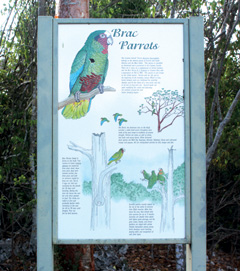 Cayman Brac Parrot. image by Phil ButlerPaul Watler from the National Trust has been plunging deep into the brush and woodlands of Cayman Brac searching for nesting and breeding grounds for the Cayman Brac Parrot.
Cayman Brac Parrot. image by Phil ButlerPaul Watler from the National Trust has been plunging deep into the brush and woodlands of Cayman Brac searching for nesting and breeding grounds for the Cayman Brac Parrot.
“We were awarded £20,000 (CI$27,497) to investigate the nesting of Cayman Brac parrots, which are a different subspecies of the Rose-throated Amazon parrot than the parrots on Grand Cayman,” said Trust Environmental Programmes Manager Mr. Watler, who has on the Brac since mid-April searching the skies and trees for the green, blue and red birds.
The people of Cayman Brac have been supporting him in his quest, giving him free accommodation and transport, which means there are extra funds available from the grant the National Trust received for the survey.
“The kind support of the people of Cayman Brac has been huge. I’m humbled by the support I’m getting here,” said Mr. Watler.
Because the Brac is so small, the native Brac parrot has the most restricted range of all the parrots in the Caribbean, leaving scientists concerned about the birds’ ability to elude extinction since their favoured nesting habitats are threatened by encroaching development and hurricanes.
The study is being done in partnership with the UK-based Royal Society for Protection of Birds with financial support from the UK Department of Environment Food and Rural Affairs’ Darwin Challenge Fund.
 The Brac Parrot Reserve is a protected area for the native parrots. – PHOTO: NORMA CONNOLLYMr. Watler is trying to identify the birds’ breeding and nesting sites, as well as their feeding grounds, so the National Trust can help protect those sites. As well as checking the Brac Parrot Reserve and its surrounding area for these sites, he is also examining other areas throughout the Bluff.
The Brac Parrot Reserve is a protected area for the native parrots. – PHOTO: NORMA CONNOLLYMr. Watler is trying to identify the birds’ breeding and nesting sites, as well as their feeding grounds, so the National Trust can help protect those sites. As well as checking the Brac Parrot Reserve and its surrounding area for these sites, he is also examining other areas throughout the Bluff.
The Department of Environment on Grand Cayman had previously applied for a grant from the UK’s Overseas Territories Environment Programme to help protect the endangered Cayman Parrot, but was turned down because Cayman does not have a national conservation law.
The fund from which the Brac Parrot project has been given money supports preserving biodiversity in UK overseas territories like the Cayman Islands, and will help the Cayman Islands meet its commitments under three global conventions: Biological Diversity, International Trade in Endangered Species of Wild Flora and Fauna, and the Conservation of Migratory Species.
Mr. Watler said he has been rising at 5.30am each day, as early as the parrots, to track them, with a few hours break in the afternoon and then returning to the parrots’ habitats until sundown. He will remain on Cayman Brac until mid-July to complete the survey.
“We want to find out what areas should be protected in terms of critical parrot habitat, and whether the current reserve should be expanded or if there are there other areas we should be looking at,” said Mr. Watler, noting that nests are also threatened by poachers who chop down nesting trees to steal chicks, which results in a lasting and permanent impact on future generations.
“We have already confirmed two nests identified 10 years ago are still being used today, which means that if you chop down that tree, that’s a nest destroyed forever,” said Mr. Watler.
He said the survey should be completed and ready by the end of this year.